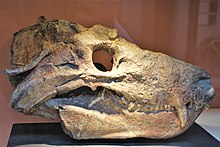Loading AI tools
Extinct genus of cynodonts From Wikipedia, the free encyclopedia
Cynognathus is an extinct genus of large-bodied cynodontian therapsids that lived in the Middle Triassic. It is known from a single species, Cynognathus crateronotus. Cynognathus was a predator closely related to mammals and had a southern hemispheric distribution. Fossils have so far been recovered from South Africa, Argentina, Antarctica, and Namibia.
| Cynognathus Temporal range: Middle Triassic, | |
|---|---|
 | |
| Fossil skull of Cynognathus | |
| Scientific classification | |
| Domain: | Eukaryota |
| Kingdom: | Animalia |
| Phylum: | Chordata |
| Clade: | Synapsida |
| Clade: | Therapsida |
| Clade: | Cynodontia |
| Clade: | †Cynognathia |
| Family: | †Cynognathidae Seeley, 1895 |
| Genus: | †Cynognathus Seeley, 1895 |
| Type species | |
| †Cynognathus crateronotus Seeley, 1895 | |

Cynognathus was a heavily built animal, and measured around 1.2 metres (3 ft 11 in)[1] in snout-to-vent body length and up to 2 metres (6 ft 7 in) in total length.[2] It had a particularly large head, up to 40 centimetres (1 ft) in length, with wide jaws and sharp teeth. Its hindlimbs were placed directly beneath the body. There has been controversy about whether the forelimbs were also held upright or sprawled outwards in a reptilian fashion, but recent studies suggest cynodonts typically held their front legs in a posture between these two extremes.[3] A study of living mammals concluded that "upright posture" in mammals is a myth based on the posture of mammal species specialized for fast running, such as dogs, hares, and antelopes; modern mammals that are not specialized for running often hold their forelimbs in a semi-sprawled posture.[4]
Possible autapomorphies of C. crateronotus include an extremely elongated postorbital bar and sectorial postcanine teeth with two serrated cusps distal to a recurved apex.[5]

During 1888 and 1889, the British paleontologist Harry Govier Seeley visited southern Africa. In 1889, near Lady Frere, at a location where earlier Alfred Brown had discovered a tooth, Seeley excavated a skull and partial postcranial skeleton of a cynodontian. In 1894, Seeley named the genus Cynognathus with as type species Cynognathus crateronotus. Simultaneously, he named three other species in the genus: Cynognathus berryi, honouring James Berry who had assisted in the excavations, Cynognathus platyceps, the "flat jaw", and Cynognathus leptorhinus, the "slender nose".[6] The generic name Cynognathus is derived from Greek kyon and gnathos, meaning "dog jaw". In 1895, Seeley published a more comprehensive description of these finds.[7]
Fossil material probably belonging to the genus has been given several different names over the years. Generic synonyms include Cynidiognathus, Cynogomphius, Karoomys, Lycaenognathus, Lycochampsa and Lycognathus. Opinions vary as to whether all remains belong to the same species. The genus Karoomys is known only from a tiny juvenile. Species-level synonyms of Cynognathus crateronotus include Cynidiognathus broomi, Cynidiognathus longiceps, Cynidiognathus merenskyi, Cynognathus berryi, Cynognathus minor, Cynognathus platyceps, Cynogomphius berryi, Karoomys browni, Lycaenognathus platyceps, Lycochampsa ferox, Lycognathus ferox, and Nythosaurus browni.

Fossils have been found in the Karoo, the Puesto Viejo Formation, Fremouw Formation, in South Africa/Lesotho, Argentina and Antarctica.
Cynognathus lived between the Anisian and the Ladinian (Middle Triassic).[8]
This genus forms a Cynognathus Assemblage Zone in the Beaufort Group of the Karoo Supergroup.[9][10][11]
Seeley in 1894/1895 placed Cynognathus in a separate family Cynognathidae, within the Cynodontia. Cynognathus is presently the only recognized member of the family Cynognathidae. Later a clade Cynognathia was named after the genus, within the Eucynodontia.
Cynognathus crateronotus in a cladogram after Stefanello et al. (2023):[12]
In the Karoo Basin in what is now South Africa, Cynognathus lived in open environments with warm, dry summers and cool, wet winters, similar to today's Western Cape region but more arid. Individuals grew rapidly and continuously. Their hunting habits were largely unaffected by the changing seasons.[13] The dentary was equipped with differentiated teeth, with fangs in the front for seizing prey and wider teeth in the rear of the jaw suitable for cutting meat;[14] these show this animal could effectively process its food before swallowing. The presence of a secondary palate in the mouth indicates that Cynognathus would have been able to breathe and swallow simultaneously. All these adaptations are consistent with maintaining a regular, high basal metabolic rate ("warm-blooded"), as in modern mammals.
The possible lack of belly ribs, in the stomach region, suggests the presence of an efficient diaphragm, an important muscle that allows mammals to breathe equally well when they are walking, running, or holding still. Pits and canals on the bone of the snout indicate concentrations of nerves and blood vessels. In mammals, these structures support special sensory hairs (whiskers), so it is likely Cynognathus had whiskers as well.
Seamless Wikipedia browsing. On steroids.
Every time you click a link to Wikipedia, Wiktionary or Wikiquote in your browser's search results, it will show the modern Wikiwand interface.
Wikiwand extension is a five stars, simple, with minimum permission required to keep your browsing private, safe and transparent.